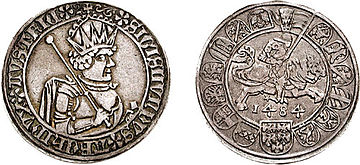- Sigismund, Archduke of Austria
-
For the 17th-century Archduke, see Archduke Sigismund Francis of Austria.
 An engraving by W. Killian, 1623.
An engraving by W. Killian, 1623.
Sigismund of Austria, Duke, then Archduke of Further Austria (26 October 1427 – 4 March 1496) was a Habsburg archduke of Austria and ruler of Tirol from 1446 to 1490.
Sigismund (or Siegmund, sometimes also spelled Sigmund) was born in Innsbruck; his parents were Frederick IV, Duke of Austria and Anna of Brunswick. He was a first cousin of Frederick III, Holy Roman Emperor, who served as regent until 1446.
Contents
Life and career
In 1446, upon the end of the regency of Frederick III, he acceded to rulership over Tirol and (other) Further Austria Vorderösterreich, which included the Sundgau in the Alsace, the Breisgau, and some possessions in Swabia. In 1449, he married Princess Eleanor of Scotland, the daughter of James I, King of Scots.
For much of his reign, Sigismund was engaged in disputes with Nicholas of Cusa, then bishop of Brixen, for the control of the Eisack, Pustertal and Inn valleys. In 1460, when he had Nicholas imprisoned, he was excommunicated by Pope Pius II. The bishop fled to Todi, but died before the archduke surrendered in order to receive the papal pardon.
In 1469, he sold his lands on the Rhine and in the Alsace to Charles, Duke of Burgundy. Sources are unclear whether he sold them due to his debts he had accumulated owing to his luxurious lifestyle or just "rented" them because he wanted to have them protected better against the expansion of the Old Swiss Confederacy. In any case, he bought back these possessions in 1474, and together with the Swiss (with whom he had concluded a peace treaty in Konstanz) and the Alsatian cities, he sided against Charles in the Battle of Héricourt.
In 1477, Frederick III made him archduke. Three years later, Eleanor died, and 1484, Sigismund married the 16-year-old Catherine of Saxony, daughter of Albert, Duke of Saxony. He had no offspring from either marriage.
 A half guldengroschen from 1484.
A half guldengroschen from 1484.
In the later years of the 1470s and early 1480s Sigismund issued a decree that instituted a radical coinage reformation that eventually led up to the creation of the world's first really large and heavy silver coin in nearly a millennium, the guldengroschen, which the Habsburgs in Bohemia developed later into the thaler. This coin was the ancestor of many the major European coin denominations to come later (and also of the US Dollar). Using new mining methods and technology, the largely quiescent silver mines in Tirol were brought back into production and soon numerous surrounding states were re-opening old mines and minting similar coins. This production of large coinage exploded as silver from the Spain's colonies in the Americas flooded the European economy. It is from these reforms in part that Sigismund acquired the nickname of der Münzreiche, or "rich in coin".
Sigismund was easily swayed by the bad advice of his council and in March 1487 entered into a pointless war with the Republic of Venice, sometimes called the War of Rovereto. Tyrolean forces quickly seized silver mines in the Valsugana valley owned by Venice, and in April 1487 Sigismund outraged Venice further when he imprisoned 130 Venetian merchants traveling to the fair at Bozen (modern Bolzano) and confiscated their goods. Tyrol stormed the Pass of Calliano and later besieged the castle at Rovereto using a massive bombard, one of the earliest times such a large piece had been used in warfare. The war continued through summer but ended with no decisive victory for either side. One notable casualty of the conflict was the condottiero Roberto Sanseverino, Prince of Salerno.
By 1490 the opposition of the population of Tirol compelled Sigismund to hand over the rulership to Archduke Maximilian I, who later became Holy Roman Emperor. Whether Sigismund voluntarily handed over power to Maximilian or was strongly coerced by the latter is not clear.
Ancestry
Albert I of Germany Albert II, Duke of Austria Elisabeth of Tirol Leopold III, Duke of Austria Ulrich III, Count of Pfirt Joanna of Pfirt Joanna of Burgundy Frederick IV, Duke of Austria Stefano Visconti of Milan Bernabò Visconti Valentina Doria Viridis Visconti Mastino II della Scala Beatrice della Scala Taddea di Carrara Sigismund, Archduke of Austria Magnus the Pious, Duke of Brunswick-Lüneburg Magnus II, Duke of Brunswick-Lüneburg Sofie von Brandenburg Frederick, Duke of Brunswick-Lüneburg Bernhard III, Prince of Anhalt-Bernburg Katharine von Anhalt-Bernburg Agnes of Saxe-Wittenberg Anna of Brunswick Rudolf I of Saxe-Wittenberg Wenceslaus I, Duke of Saxe-Wittenberg Agnes of Lindow Anna of Saxe-Wittenberg Francis of Cararra, Count of Padua Cecilia of Cararra See also
- Burgundy Wars
External links
References
- Baillie-Grohman, William Adolph (1907). The Land in the Mountains. Philadelphia: J. B. Lippincott Company. pp. 93–96.
- Coxe, William (1847). History of the House of Austria (Third Edition ed.). London: Henry G. Bohn, York Street, Covent Garden.
- Van Dyke, Paul, Paul (1905). Renascence Portraits. New York: Charles Scribner's Sons.
Preceded by
Duke Frederick IVDuke of Further Austria Succeeded by
Archduke Maximilian ICategories:- 1427 births
- 1496 deaths
- People from Innsbruck
- Counts of Tyrol
- House of Habsburg
- People excommunicated by the Roman Catholic Church
Wikimedia Foundation. 2010.
